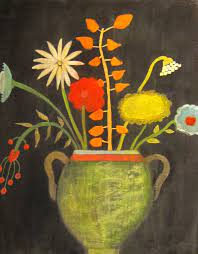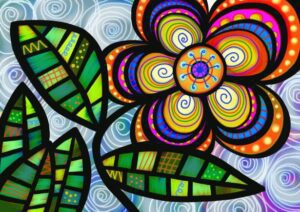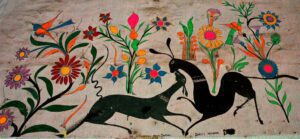Folk art is the heartbeat of a culture’s visual expression, untrained yet pulsating with raw creativity and traditional narratives.
It’s a world where community stories and personal experiences are painted, stitched, and sculpted into existence.
We’ll jump into the vibrant tapestry of folk art, exploring its roots and significance.
Stay tuned as we uncover why this art form resonates so deeply across different communities and time periods.
Origins Of Folk Art
Folk art has roots deeply embedded in the cultural soil of each society.
We find its beginnings intertwined with the earliest expressions of human creativity, as common folks crafted items infused with aesthetic value beyond their practical uses.
These creations served not only utilitarian purposes but also reflected the makers’ visions of the world around them.
Entrancing patterns and vibrant colors often characterize these early artistic endeavors.
Traditional festivals, religious ceremonies, and personal life events became the canvas for the display of folk art, reinforcing its role as both a visual narrative and a social document.
The evolution of folk art is marked by its inherent adaptability –
- Mirroring societal changes,
- Reflecting political climates,
- Adhering to religious and spiritual beliefs.
As we jump into the regional distinctions within folk art, we uncover a tapestry of styles unique to specific areas.
Each bearing its own hallmark features, intricately woven into the local culture, and often passed down through generations.
It is this transmission of skills and stories that anchors folk art in the collective consciousness of a community.
Characteristics Of Folk Art
Folk art embodies the heartbeat of a culture, often encapsulating the essence of a community’s identity.

Through its distinct characteristics, it reveals stories of traditions, values, and the everyday experiences of people.
Accessibility And Functionality
We find that a key attribute of folk art is its accessibility.
Unlike the exclusivity often associated with fine art, folk art is by and for the common people.
Typically created from readily available materials, it holds a purpose beyond mere aesthetic value – often serving a practical function in daily life.

This utilitarian nature lends a certain honesty to each piece, merging art with the rhythms of ordinary existence.
Community And Individuality
Even though its roots in community expression, folk art isn’t a stranger to individuality.
Every stroke, carve, or weave tells of the artist’s personal experience interlaced with communal narratives.
We see these stories unfold in:
- Hand-woven textiles,
- Pottery with traditional motifs – Carvings infused with local myths These creations not only display the artist’s skill but also reinforce their connection to a larger cultural tapestry.
Simplicity And Symbolism
Don’t mistake simplicity for a lack of depth in folk art.
Often, the uncomplicated forms and techniques used are heavy with symbolism and meaning.
For instance, colors in Mexican Amate paintings aren’t just vibrantly adorning the canvas – they symbolize elements such as earth, wind, and the divine.
We examine these symbols to understand the deeper values and beliefs that guide these communities.
Evolution And Continuity
We recognize that while folk art is steeped in tradition, it’s not a static form.
Each generation adds their voice, allowing folk art to evolve while maintaining a thread of continuity.
The ability of folk art to adapt and transform while preserving a cultural lineage is proof of its enduring relevance.
In every corner of the world, folk art lives on as a vibrant expression of the human spirit.
From the Guatemalan Worry Dolls that safeguard children’s dreams to the poignant urban murals across city walls, folk art continues to evolve, yet it remains timeless in its reflection of life’s universals.
Regional Variations In Folk Art
Folk art is not a monolith; it varies dramatically from region to region, each with its own distinct flavor and tradition.
As storytellers through the lens, we appreciate the diverse narratives that these regional styles convey.
From the vibrant textile patterns of Andean weavers to the elaborate wooden carvings of Russian artisans, every culture has its own way of expressing its identity through folk art.
Just as every film has a unique setting and aesthetic, folk art speaks to its origins through colors, materials, and techniques.
Some regions are particularly noted for certain types of folk art:
- Scandinavia – lauded for its minimalist yet functional woodwork and textiles.
- Mexico – known for its colorful ceramics and Day of the Dead iconography.
- India – famed for its intricate embroidery and metalwork.
These regional variations in folk art don’t just add aesthetic diversity; they also bear witness to the geography and resources of each area.
Our exploration of folk art as filmmakers similarly integrates the physical and cultural landscape into our narratives, setting a rich context that enhances the story.
Materials also play a significant role in shaping regional folk art.

Local resources dictate the medium artists work with, creating a direct connection between art and environment.
In regions abundant with natural fibers, basketry and weaving flourish, while the availability of wood or stone may lead to a tradition rich in sculpture.
By understanding these regional peculiarities, we gain insight into not only the art form itself but also the ingenuity and adaptability of its creators.
Through our engagement with folk art, we deepen our appreciation for the diversity of human expression.
Observing these distinctions, we can’t help but draw parallels to filmmaking, where every location informs the visual style of a piece, and every culture presents a new palette of stories to be told.
Folk Art And Cultural Significance
Folk art resonates with cultural significance, often capturing the essence of a community’s identity.
Through various mediums, artists convey experiences and traditions that have been passed down through generations.
We see this vividly in creations like Amate bark paintings from Mexico or the intricate Mithila paintings from India, which are not just decorative but also steep in cultural narratives.
The power of folk art lies in its ability to bridge the past with the present.
These artworks serve as repositories of collective memory, illuminating a community’s history, values, and beliefs.
We look at intricate quilt patterns from the American South or the storytelling charm of Russian Matryoshka dolls – each stitch and carved figure is a testament to the cultural fabric from which they originate.
- Capturing communal identity,
- Highlight cultural narratives,
- Preserving collective memory.
Folk art is not static, and its evolution is closely linked to societal changes.
Whether reflecting on political unrest, celebrating a harvest, or mourning loss, these pieces offer a direct line to the heartbeat of society.
In our work, we’ve seen how these expressions can rival even the most nuanced documentary films in their portrayal of raw human emotion and societal dynamics.
In considering art as a universal language, folk art speaks volumes about the human experience.
From the hand-woven baskets of Native American tribes to the vibrant street art found in urban landscapes, each piece tells a story beyond its aesthetic appeal.
As aficionados of both art and filmmaking, we recognize these stories as integral to understanding the broader human narrative.
- Reflecting societal changes,
- Portraying raw human emotion,
- Telling stories beyond aesthetics.
Materials and techniques are deeply rooted in local customs, contributing to the uniqueness of each piece.
We find that the choice of material often reflects the surrounding environment and available resources, which further emphasizes the connection to the artist’s homeland.
This sense of place is profound, as with the use of local clays in pottery or the natural dyes in textile work, binding the artwork inseparably to its cultural landscape.
- Rooted in local customs,
- Choice of materials reflects the environment.
Contemporary Folk Art
Folk art isn’t just a relic from the past; it thrives in the present, continuously adapting to modern contexts.
We often see how today’s artists draw on traditional techniques while incorporating contemporary themes – this fusion is what keeps folk art relevant and emotionally resonant in our fast-paced world.
Artists like Faith Ringgold and Betye Saar have masterfully blended storytelling with sociopolitical commentary in their works, showcasing that folk art serves as a platform for both personal expression and cultural critique.
Melding the past with the present, they highlight issues of race, gender, and identity through the lens of folk artistry.
In our examination of folk art’s current iteration, we find that it often:
- Addresses global concerns and universal human experiences,
- Reflects the digital zeitgeist through mixed media incorporating technology,
- Utilizes recycled materials, aligning with sustainable practices.
Through filmmaking, we’ve seen similar trends, with directors like Wes Anderson and Hayao Miyazaki creating worlds that blend a folk aesthetic with modern storytelling.
Their films, like The Grand Budapest Hotel and Spirited Away, respectively, carry the essence of folk tales into the realm of cinematic grandeur.
With accessibility to international markets thanks to online platforms, folk artists are finding new audiences.
We observe that platforms like Etsy and Pinterest play pivotal roles in breathing new life into the traditions of folk art, making it not just accessible but also lucrative for the artists who dedicate themselves to this craft.
It’s clear that the dialogue between past and present elements in folk art is not a mere echo — it’s a loud, ongoing conversation.
This exchange spearheads innovation within the genre, ensuring its evolution doesn’t stagnate but rather progresses with the times.
Artists continue to push boundaries by incorporating contemporary issues and technologies, while holding fast to the age-old principles that make folk art enduringly appealing.

What Is Folk Art – Wrap Up
We’ve seen that folk art is not just a relic of the past but a living tradition that adapts to the times while honoring its origins.
It’s a testament to the enduring human urge to create and communicate through the language of the heart.
As we continue to witness the evolution of folk art, we’re reminded that it’s a powerful medium for storytelling, connecting us to our roots and to each other.
Whether through the hands of a traditional craftsperson or the innovative mind of a contemporary artist, folk art remains a vibrant and essential part of our cultural fabric.
It’s our collective narrative woven into every stitch, carved into every block, and painted onto every canvas.
Let’s cherish and support this dynamic art form as it continues to tell our stories and reflect our shared humanity.
Frequently Asked Questions
What Is Folk Art And What Does It Reflect?
Folk art is a form of creative expression that emerges from the heart of a community, reflecting its cultural traditions, societal changes, and religious beliefs.
It often incorporates common materials and is recognizable by its simplicity and symbolic elements.
How Does Folk Art Differ From One Region To Another?
Regional variations in folk art showcase the diverse narratives and creative expressions unique to different cultural landscapes.
These differences are often influenced by available materials, environment, and local customs.
Can Folk Art Adapt To Modern Contexts?
Yes, contemporary folk art continues to evolve by blending traditional techniques with modern themes.
It thrives by addressing global concerns, reflecting the digital age, and often incorporating recycled materials, illustrating its adaptive and dynamic nature.
How Does Folk Art Maintain Continuity While Evolving?
Folk art maintains a continuity by preserving its cultural core and expressive simplicity, even as it adopts new forms and thematic explorations to remain relevant and resonant in changing times.
Why Is Folk Art Important In Preserving Cultural Identity?
Folk art plays a crucial role in capturing communal identity and preserving collective memories.
It is a tangible representation of a community’s history, values, and shared experiences, contributing to the cultural richness of society.
What Roles Do Materials Play In Folk Art?
Materials in folk art are more than just mediums for expression; they reflect the environment and are intimately tied to the cultural identity of the artwork.
The choice of materials can reveal much about the geographical and societal context of the art.
How Has The Internet Affected The World Of Folk Art?
The internet has significantly expanded the reach and accessibility of folk art.
It provides a platform for artists to share their work globally, creating a market that is both lucrative and supportive of the preservation and evolution of folk art traditions.


